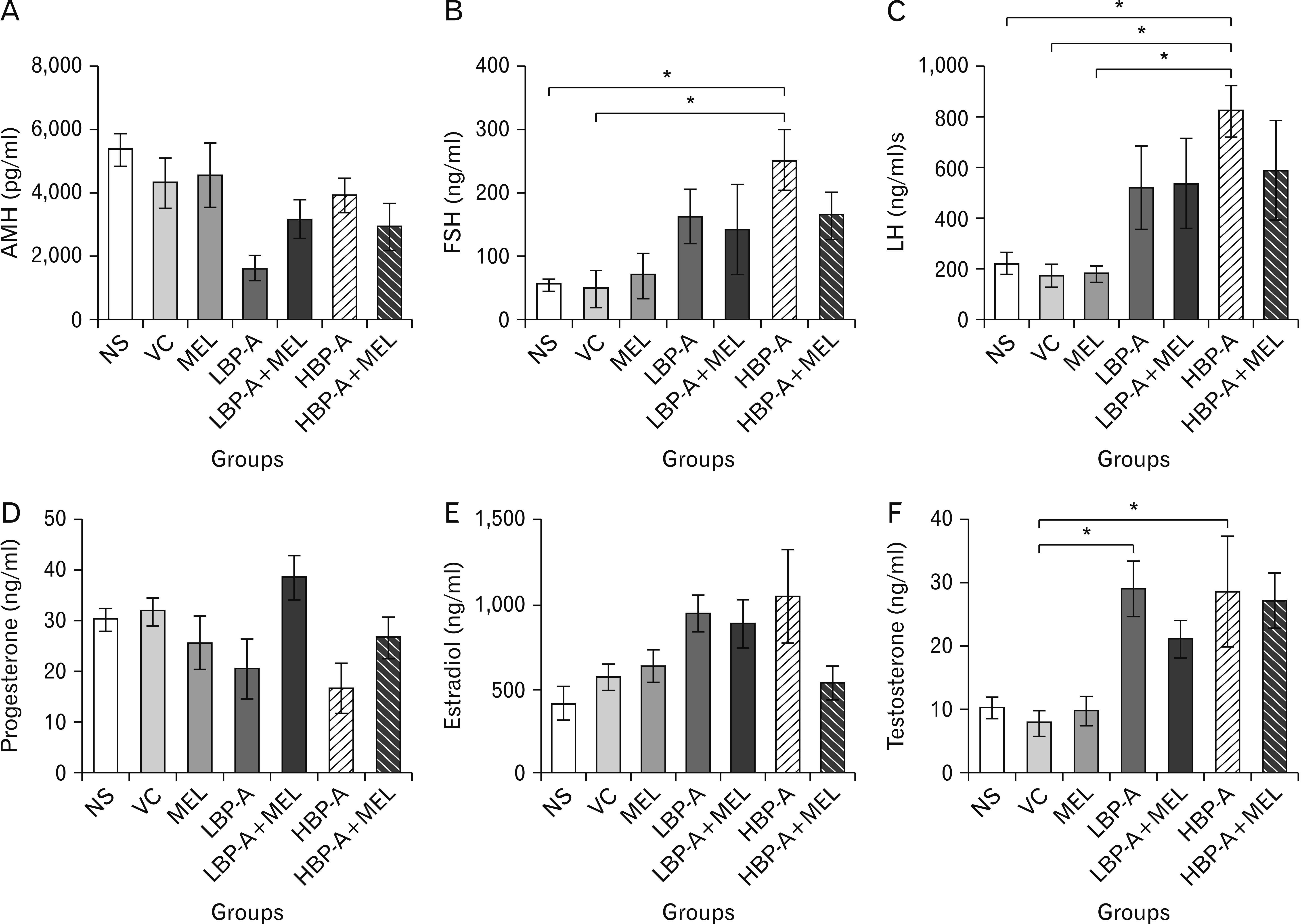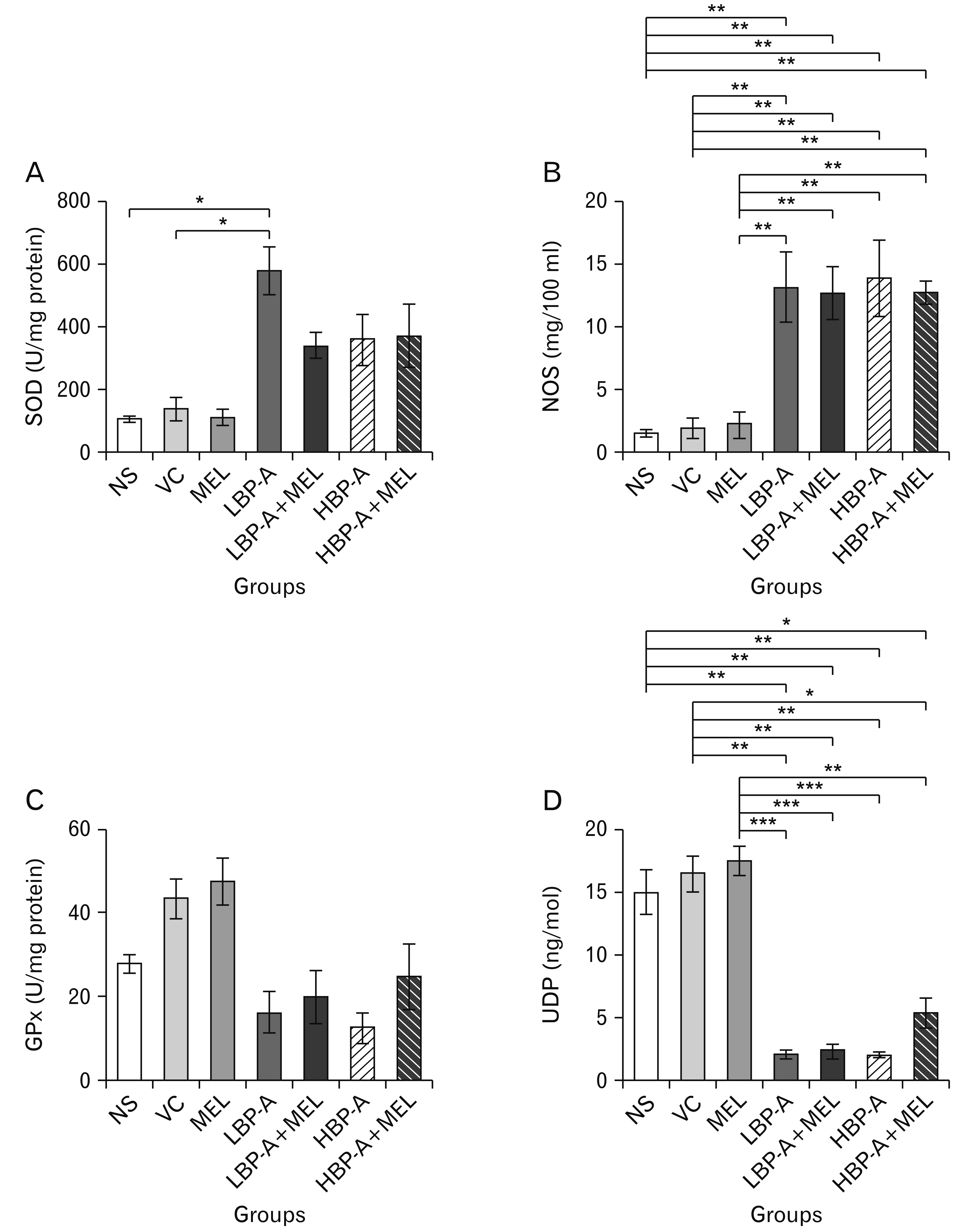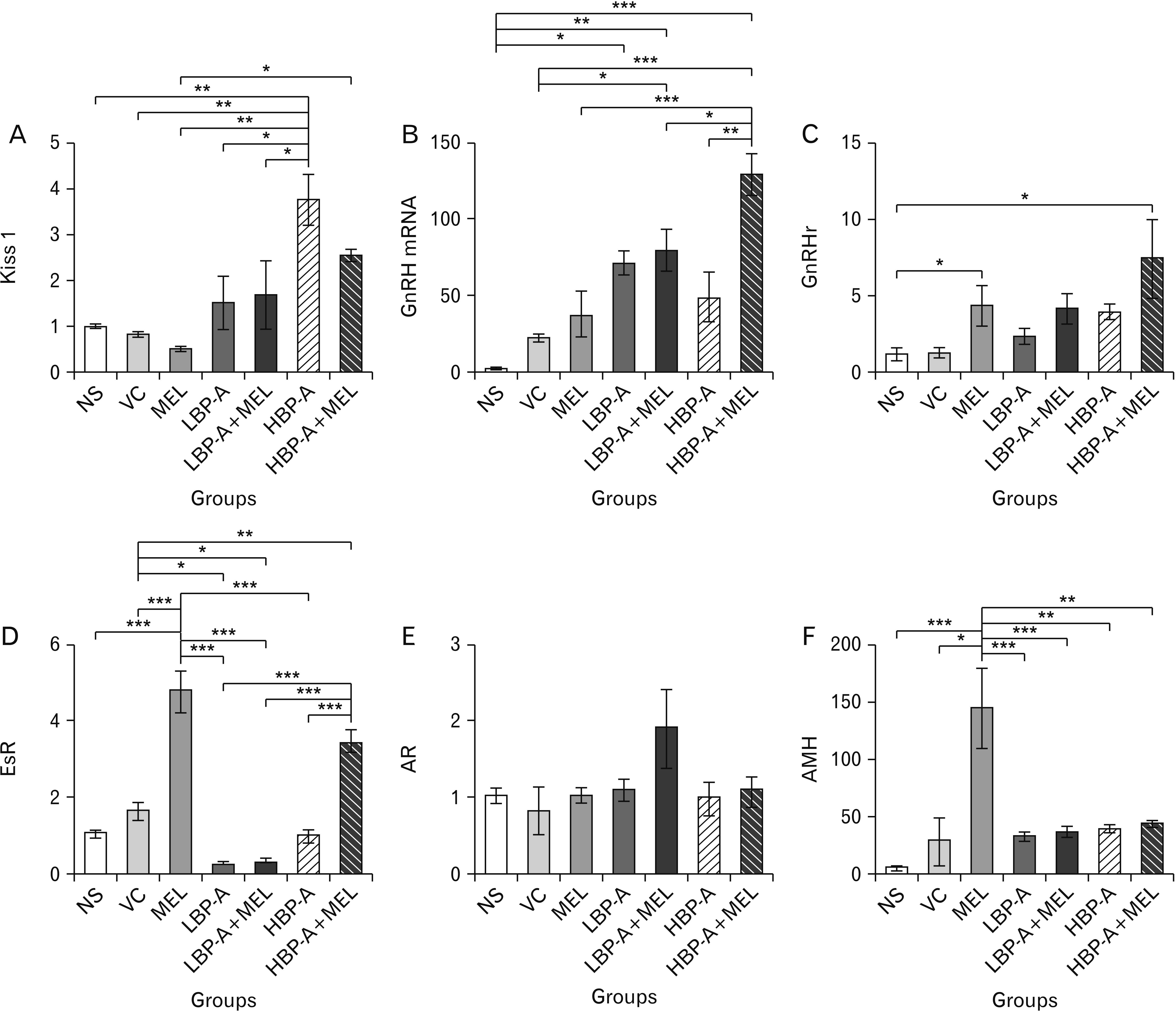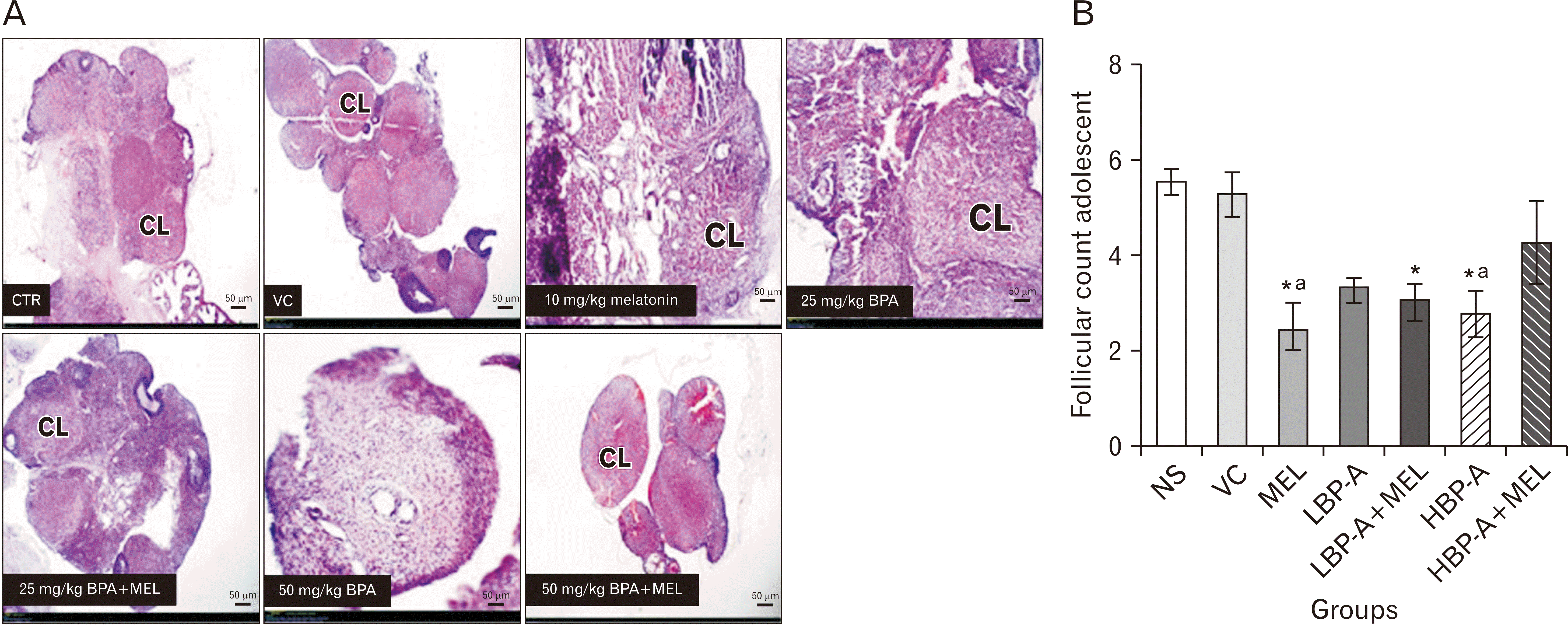1. Geens T, Apelbaum TZ, Goeyens L, Neels H, Covaci A. 2010; Intake of bisphenol A from canned beverages and foods on the Belgian market. Food Addit Contam Part A Chem Anal Control Expo Risk Assess. 27:1627–37. DOI:
10.1080/19440049.2010.508183. PMID:
20835936.

3. vom Saal FS, Hughes C. 2005; An extensive new literature concerning low-dose effects of bisphenol A shows the need for a new risk assessment. Environ Health Perspect. 113:926–33. DOI:
10.1289/ehp.7713. PMID:
16079060. PMCID:
PMC1280330.

4. Schug TT, Barouki R, Gluckman PD, Grandjean P, Hanson M, Heindel JJ. 2013; PPTOX III: environmental stressors in the developmental origins of disease--evidence and mechanisms. Toxicol Sci. 131:343–50. DOI:
10.1093/toxsci/kfs267. PMID:
22956631. PMCID:
PMC3551422.

5. Kamel AH, Foaud MA, Moussa HM. 2018; The adverse effects of bisphenol A on male albino rats. J Basic Appl Zool. 79:6. DOI:
10.1186/s41936-018-0015-9.

6. Bae S, Kim JH, Lim YH, Park HY, Hong YC. 2012; Associations of bisphenol A exposure with heart rate variability and blood pressure. Hypertension. 60:786–93. DOI:
10.1161/HYPERTENSIONAHA.112.197715. PMID:
22851732.

7. Melzer D, Osborne NJ, Henley WE, Cipelli R, Young A, Money C, McCormack P, Luben R, Khaw KT, Wareham NJ, Galloway TS. 2012; Urinary bisphenol A concentration and risk of future coronary artery disease in apparently healthy men and women. Circulation. 125:1482–90. DOI:
10.1161/CIRCULATIONAHA.111.069153. PMID:
22354940.

8. Shankar A, Teppala S, Sabanayagam C. 2012; Urinary bisphenol a levels and measures of obesity: results from the national health and nutrition examination survey 2003-2008. ISRN Endocrinol. 2012:965243. DOI:
10.5402/2012/965243. PMID:
22852093. PMCID:
PMC3407638.

9. Chevrier J, Gunier RB, Bradman A, Holland NT, Calafat AM, Eskenazi B, Harley KG. 2013; Maternal urinary bisphenol a during pregnancy and maternal and neonatal thyroid function in the CHAMACOS study. Environ Health Perspect. 121:138–44. DOI:
10.1289/ehp.1205092. PMID:
23052180. PMCID:
PMC3553432.

11. Schwarzbauer J, Heim S, Brinker S, Littke R. 2002; Occurrence and alteration of organic contaminants in seepage and leakage water from a waste deposit landfill. Water Res. 36:2275–87. DOI:
10.1016/S0043-1354(01)00452-3. PMID:
12108720.

12. Lunardi D, Abelli L, Panti C, Marsili L, Fossi MC, Mancia A. 2016; Transcriptomic analysis of bottlenose dolphin (Tursiops truncatus) skin biopsies to assess the effects of emerging contaminants. Mar Environ Res. 114:74–9. DOI:
10.1016/j.marenvres.2016.01.002. PMID:
26794494.

13. Berhane TM, Levy J, Krekeler MPS, Danielson ND. 2017; Kinetic sorption of contaminants of emerging concern by a palygorskite-montmorillonite filter medium. Chemosphere. 176:231–42. DOI:
10.1016/j.chemosphere.2017.02.068. PMID:
28273530.

14. Xiao C, Wang L, Zhou Q, Huang X. 2020; Hazards of bisphenol A (BPA) exposure: a systematic review of plant toxicology studies. J Hazard Mater. 384:121488. DOI:
10.1016/j.jhazmat.2019.121488. PMID:
31699483.

15. Liang H, Xu W, Chen J, Shi H, Zhu J, Liu X, Wang J, Miao M, Yuan W. 2017; The association between exposure to environmental bisphenol A and gonadotropic hormone levels among men. PLoS One. 12:e0169217. DOI:
10.1371/journal.pone.0169217. PMID:
28085949. PMCID:
PMC5234835.

16. Völkel W, Colnot T, Csanády GA, Filser JG, Dekant W. 2002; Metabolism and kinetics of bisphenol A in humans at low doses following oral administration. Chem Res Toxicol. 15:1281–7. DOI:
10.1021/tx025548t. PMID:
12387626.

17. Jones BA, Watson NV. 2012; Perinatal BPA exposure demasculinizes males in measures of affect but has no effect on water maze learning in adulthood. Horm Behav. 61:605–10. DOI:
10.1016/j.yhbeh.2012.02.011. PMID:
22370244.

18. Palanza P, Gioiosa L, vom Saal FS, Parmigiani S. 2008; Effects of developmental exposure to bisphenol A on brain and behavior in mice. Environ Res. 108:150–7. DOI:
10.1016/j.envres.2008.07.023. PMID:
18949834.

19. Perera F, Vishnevetsky J, Herbstman JB, Calafat AM, Xiong W, Rauh V, Wang S. 2012; Prenatal bisphenol a exposure and child behavior in an inner-city cohort. Environ Health Perspect. 120:1190–4. DOI:
10.1289/ehp.1104492. PMID:
22543054. PMCID:
PMC3440080.

20. Almeida S, Raposo A, Almeida-González M, Carrascosa C. 2018; Bisphenol A: food exposure and impact on human health. Compr Rev Food Sci Food Saf. 17:1503–17. DOI:
10.1111/1541-4337.12388. PMID:
33350146.

21. Sharma M, Sharma R, Gupta P, ivastava S Sr. 2019; Bisphenol- A induced oxidative stress and its fertility aspects. Int J Pharm Sci Res. 10:3519–31.
22. Gassman NR. 2017; Induction of oxidative stress by bisphenol A and its pleiotropic effects. Environ Mol Mutagen. 58:60–71. DOI:
10.1002/em.22072. PMID:
28181297. PMCID:
PMC5458620.

23. Haroun MR, Zamzam IS, Metwally ES, EL-Shafey RS. 2016; Effect of vitamin C on bisphenol A induced hepato& nephrotoxicity in albino rats. Egypt J Forensic Sci Appli Toxicol. 16(Suppl):57–85. DOI:
10.21608/ejfsat.2016.41639.
24. Elwakeel SHB, El-Monem DDA. 2018; Ameliorative effect of melatonin and quercetin against bisphenol A induced reproductive toxicity in male albino mice. Cienc Tec Vitivinic. 33:31–64.
25. Olukole SG, Ola-Davies EO, Lanipekun DO, Oke BO. 2020; Chronic exposure of adult male Wistar rats to bisphenol A causes testicular oxidative stress: role of gallic acid. Endocr Regul. 54:14–21. DOI:
10.2478/enr-2020-0003. PMID:
32597147.

26. Mohamad Zaid SS, Kassim NM, Othman S. 2015; Tualang honey protects against BPA-induced morphological abnormalities and disruption of ERα, ERβ, and C3 mRNA and protein expressions in the uterus of rats. Evid Based Complement Alternat Med. 2015:202874. DOI:
10.1155/2015/202874. PMID:
26788107. PMCID:
PMC4691614.

27. Ullah A, Pirzada M, Jahan S, Ullah H, Khan MJ. 2019; Bisphenol A analogues bisphenol B, bisphenol F, and bisphenol S induce oxidative stress, disrupt daily sperm production, and damage DNA in rat spermatozoa: a comparative
in vitro and
in vivo study. Toxicol Ind Health. 35:294–303. DOI:
10.1177/0748233719831528. PMID:
30871434.
28. Kaur S, Singh G, Sadwal S, Aniqa A. 2020; Alleviating impact of hydroethanolic Murraya koenigii leaves extract on bisphenol A instigated testicular lethality and apoptosis in mice. Andrologia. 52:e13504. DOI:
10.1111/and.13504. PMID:
31912924.

29. Ma S, Li R, Gong X, Shi W, Zhong X. 2018; Lycopene reduces in utero bisphenol A exposure-induced mortality, benefits hormones, and development of reproductive organs in offspring mice. Environ Sci Pollut Res Int. 25:24041–51. DOI:
10.1007/s11356-018-2395-2. PMID:
29948678.

30. El Morsy EM, Ahmed M. 2020; Protective effects of lycopene on hippocampal neurotoxicity and memory impairment induced by bisphenol A in rats. Hum Exp Toxicol. 39:1066–78. DOI:
10.1177/0960327120909882. PMID:
32153214.

31. Elgawish RA, El-Beltagy MA, El-Sayed RM, Gaber AA, Abdelrazek HMA. 2020; Protective role of lycopene against metabolic disorders induced by chronic bisphenol A exposure in rats. Environ Sci Pollut Res Int. 27:9192–201. DOI:
10.1007/s11356-019-07509-5. PMID:
31916151.

32. Anjum S, Rahman S, Kaur M, Ahmad F, Rashid H, Ansari RA, Raisuddin S. 2011; Melatonin ameliorates bisphenol A-induced biochemical toxicity in testicular mitochondria of mouse. Food Chem Toxicol. 49:2849–54. DOI:
10.1016/j.fct.2011.07.062. PMID:
21840368.

33. Reiter RJ, Mayo JC, Tan DX, Sainz RM, Alatorre-Jimenez M, Qin L. 2016; Melatonin as an antioxidant: under promises but over delivers. J Pineal Res. 61:253–78. DOI:
10.1111/jpi.12360. PMID:
27500468.

34. Wu HJ, Liu C, Duan WX, Xu SC, He MD, Chen CH, Wang Y, Zhou Z, Yu ZP, Zhang L, Chen Y. 2013; Melatonin ameliorates bisphenol A-induced DNA damage in the germ cells of adult male rats. Mutat Res. 752:57–67. DOI:
10.1016/j.mrgentox.2013.01.005. PMID:
23402883.

35. FAO/WHO. 2011. In : Toxicological and Health Aspects of Bisphenol A Report of Joint FAO/WHO Expert Meeting; 2010 Nov 2-5; Ottawa, Canada. WHO;Geneva: p. 60.
36. Peretz J, Vrooman L, Ricke WA, Hunt PA, Ehrlich S, Hauser R, Padmanabhan V, Taylor HS, Swan SH, VandeVoort CA, Flaws JA. 2014; Bisphenol A and reproductive health: update of experimental and human evidence, 2007-2013. Environ Health Perspect. 122:775–86. DOI:
10.1289/ehp.1307728. PMID:
24896072. PMCID:
PMC4123031.

37. Richter CA, Birnbaum LS, Farabollini F, Newbold RR, Rubin BS, Talsness CE, Vandenbergh JG, Walser-Kuntz DR, vom Saal FS. 2007; In vivo effects of bisphenol A in laboratory rodent studies. Reprod Toxicol. 24:199–224. DOI:
10.1016/j.reprotox.2007.06.004. PMID:
17683900. PMCID:
PMC2151845.

38. Vandenberg LN, Ehrlich S, Belcher SM, Ben-Jonathan N, Dolinoy DC, Hugo ER, Hunt PA, Newbold RR, Rubin BS, Saili KS, Soto AM, Wang HS, vom Saal FS. 2013; Low dose effects of bisphenol A: an integrated review of
in vitro, laboratory animal, and epidemiology studies. Endocr Disrupt. 1:e26490. DOI:
10.4161/endo.26490.
39. vom Saal FS, Akingbemi BT, Belcher SM, Birnbaum LS, Crain DA, Eriksen M, Farabollini F, Guillette LJ Jr, Hauser R, Heindel JJ, Ho SM, Hunt PA, Iguchi T, Jobling S, Kanno J, Keri RA, Knudsen KE, Laufer H, LeBlanc GA, Marcus M, McLachlan JA, Myers JP, Nadal A, Newbold RR, Olea N, Prins GS, Richter CA, Rubin BS, Sonnenschein C, Soto AM, Talsness CE, Vandenbergh JG, Vandenberg LN, Walser-Kuntz DR, Watson CS, Welshons WV, Wetherill Y, Zoeller RT. 2007; Chapel Hill bisphenol A expert panel consensus statement: integration of mechanisms, effects in animals and potential to impact human health at current levels of exposure. Reprod Toxicol. 24:131–8. DOI:
10.1016/j.reprotox.2007.07.005. PMID:
17768031. PMCID:
PMC2967230.

40. Helal EGE, Mohamed AM, Taha NM. 2016; Effect of bisphenol A on the first generation of female rats from both parents treated with the same xenoestrogen. Egypt J Hosp Med. 64:389–94. DOI:
10.12816/0029030.

41. Pivonello C, Muscogiuri G, Nardone A, Garifalos F, Provvisiero DP, Verde N, de Angelis C, Conforti A, Piscopo M, Auriemma RS, Colao A, Pivonello R. 2020; Bisphenol A: an emerging threat to female fertility. Reprod Biol Endocrinol. 18:22. DOI:
10.1186/s12958-019-0558-8. PMID:
32171313. PMCID:
PMC7071611.

42. Galloway T, Cipelli R, Guralnik J, Ferrucci L, Bandinelli S, Corsi AM, Money C, McCormack P, Melzer D. 2010; Daily bisphenol A excretion and associations with sex hormone concentrations: results from the InCHIANTI adult population study. Environ Health Perspect. 118:1603–8. DOI:
10.1289/ehp.1002367. PMID:
20797929. PMCID:
PMC2974700.

43. Lassen TH, Frederiksen H, Jensen TK, Petersen JH, Joensen UN, Main KM, Skakkebaek NE, Juul A, Jørgensen N, Andersson AM. 2014; Urinary bisphenol A levels in young men: association with reproductive hormones and semen quality. Environ Health Perspect. 122:478–84. DOI:
10.1289/ehp.1307309. PMID:
24786630. PMCID:
PMC4014766.

44. Anderson RA, Lincoln GA, Wu FC. 1993; Melatonin potentiates testosterone-induced suppression of luteinizing hormone secretion in normal men. Hum Reprod. 8:1819–22. DOI:
10.1093/oxfordjournals.humrep.a137940. PMID:
8288743.
45. Grasselli F, Baratta L, Baioni L, Bussolati S, Ramoni R, Grolli S, Basini G. 2010; Bisphenol A disrupts granulosa cell function. Domest Anim Endocrinol. 39:34–9. DOI:
10.1016/j.domaniend.2010.01.004. PMID:
20172683.

47. Meczekalski B, Czyzyk A, Kunicki M, Podfigurna-Stopa A, Plociennik L, Jakiel G, Maciejewska-Jeske M, Lukaszuk K. 2016; Fertility in women of late reproductive age: the role of serum anti-Müllerian hormone (AMH) levels in its assessment. J Endocrinol Invest. 39:1259–65. DOI:
10.1007/s40618-016-0497-6. PMID:
27300031. PMCID:
PMC5069312.

48. Wang Z, Liu H, Liu S. 2016; Low-dose bisphenol A exposure: a seemingly instigating carcinogenic effect on breast cancer. Adv Sci (Weinh). 4:1600248. DOI:
10.1002/advs.201600248. PMID:
28251049. PMCID:
PMC5323866.

49. Leem YH, Oh S, Kang HJ, Kim JH, Yoon J, Chang JS. 2017; BPA-toxicity via superoxide anion overload and a deficit in β-catenin signaling in human bone mesenchymal stem cells. Environ Toxicol. 32:344–52. DOI:
10.1002/tox.22239. PMID:
26822619. PMCID:
PMC5217073.

50. Khan S, Beigh S, Chaudhari BP, Sharma S, Aliul Hasan Abdi S, Ahmad S, Ahmad F, Parvez S, Raisuddin S. 2016; Mitochondrial dysfunction induced by bisphenol A is a factor of its hepatotoxicity in rats. Environ Toxicol. 31:1922–34. DOI:
10.1002/tox.22193. PMID:
26450347.

51. Zhou C, Wang W, Peretz J, Flaws JA. 2015; Bisphenol A exposure inhibits germ cell nest breakdown by reducing apoptosis in cultured neonatal mouse ovaries. Reprod Toxicol. 57:87–99. DOI:
10.1016/j.reprotox.2015.05.012. PMID:
26049153. PMCID:
PMC4550517.

52. Prasanth GK, Divya Lakshmanan M, Sadasivan C. 2013; Bisphenol-A can inhibit the enzymatic activity of human superoxide dismutase. Hum Ecol Risk Assess. 19:268–77. DOI:
10.1080/10807039.2012.683720.

53. Huo X, Chen D, He Y, Zhu W, Zhou W, Zhang J. 2015; Bisphenol-A and female infertility: a possible role of gene-environment interactions. Int J Environ Res Public Health. 12:11101–16. DOI:
10.3390/ijerph120911101. PMID:
26371021. PMCID:
PMC4586663.
54. Othman AI, Edrees GM, El-Missiry MA, Ali DA, Aboel-Nour M, Dabdoub BR. 2016; Melatonin controlled apoptosis and protected the testes and sperm quality against bisphenol A-induced oxidative toxicity. Toxicol Ind Health. 32:1537–49. DOI:
10.1177/0748233714561286. PMID:
25537623.

55. Balakrishnan N, Sendhilvadivu M. 2018; Vitamin E modulates the oxidant-antioxidant imbalance of BPA induced oxidative stress in albino rats. Int J Sci Res. 7:900–6.
56. Saadeldin IM, Hussein MA, Suleiman AH, Abohassan MG, Ahmed MM, Moustafa AA, Moumen AF, Abdel-Aziz Swelum A. 2018; Ameliorative effect of ginseng extract on phthalate and bisphenol A reprotoxicity during pregnancy in rats. Environ Sci Pollut Res Int. 25:21205–15. DOI:
10.1007/s11356-018-2299-1. PMID:
29777495.

59. Dhagga N, Gupta P, Seema S. 2017; Histological effects of bisphenol- A on reproductive organs of female Wistar rats. Int J Adv Res. 5:152–62. DOI:
10.21474/IJAR01/5749.

60. Abecia JA, Forcada F, Casao A, Palacín I. 2008; Effect of exogenous melatonin on the ovary, the embryo and the establishment of pregnancy in sheep. Animal. 2:399–404. DOI:
10.1017/S1751731107001383. PMID:
22445042.

61. Maganhin CC, Fuchs LF, Simões RS, Oliveira-Filho RM, de Jesus Simões M, Baracat EC, Soares JM Jr. 2013; Effects of melatonin on ovarian follicles. Eur J Obstet Gynecol Reprod Biol. 166:178–84. DOI:
10.1016/j.ejogrb.2012.10.006. PMID:
23102587.

62. Aydin V, Ömeroğlu S, Kartal B, Coşkun-Akçay N, Akarca-Dizakar SÖ, Türkoğlu İ, Dernek D. 2017; The effects of antioxidant melatonin on rat ovary neonatal exposure to bisphenol A. Duzce Med J. 19:33–7.
63. Abdollahifar MA, Azad N, Sajadi E, Shams Mofarahe Z, Zare F, Moradi A, Rezaee F, Gholamin M, Abdi S. 2019; Vitamin C restores ovarian follicular reservation in a mouse model of aging. Anat Cell Biol. 52:196–203. DOI:
10.5115/acb.2019.52.2.196. PMID:
31338237. PMCID:
PMC6624328.










 PDF
PDF Citation
Citation Print
Print



 XML Download
XML Download